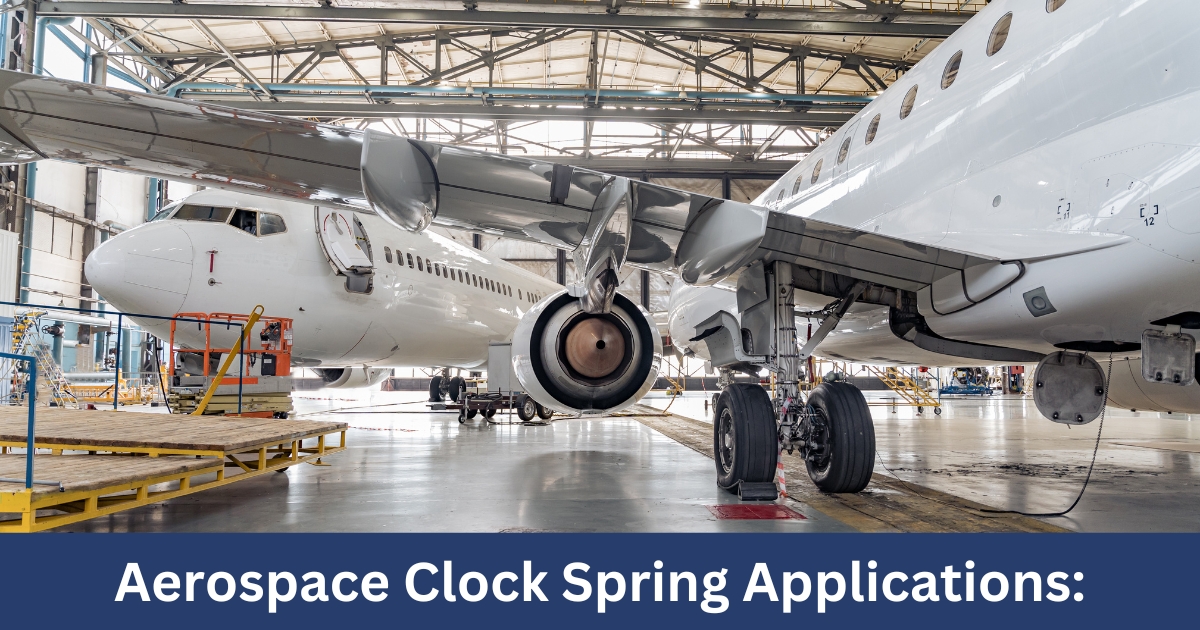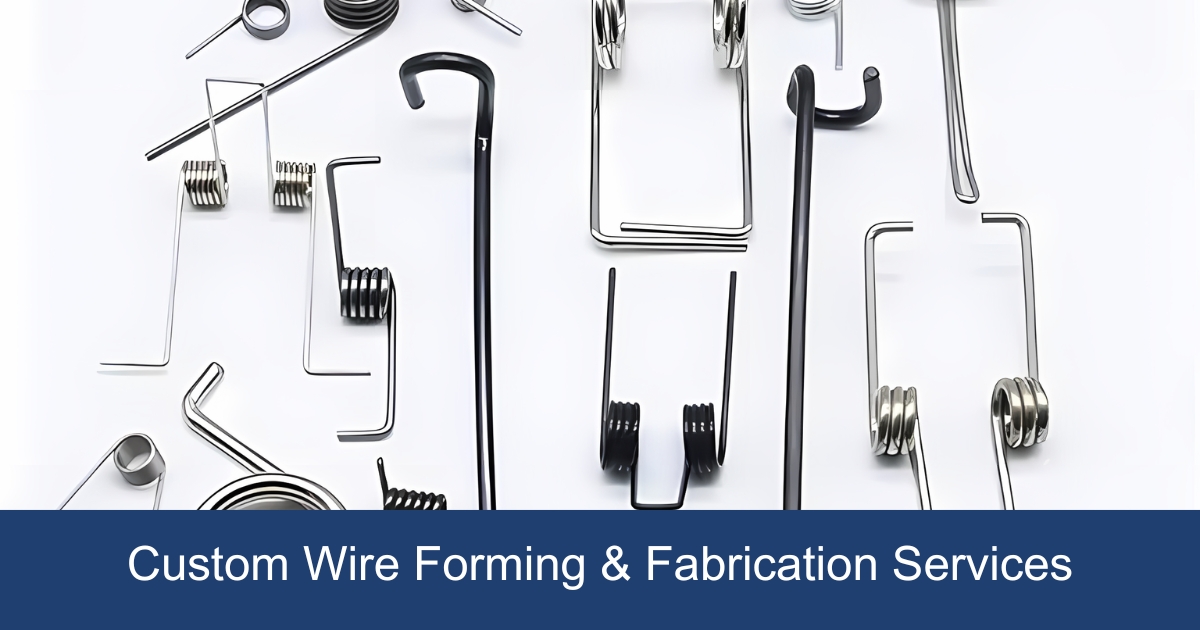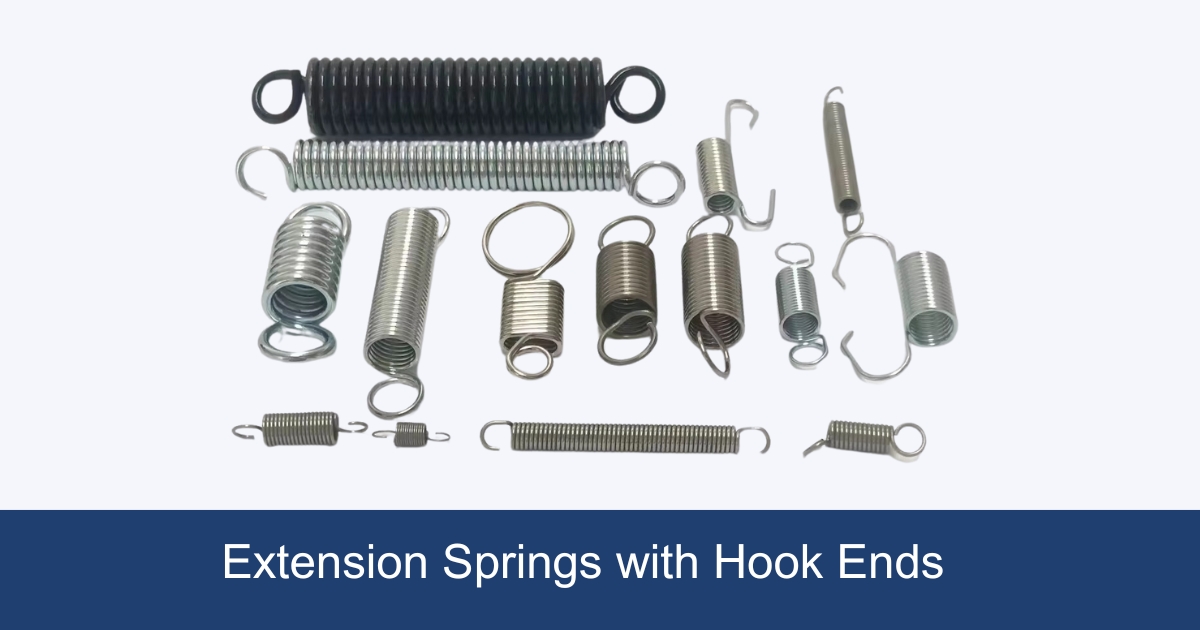Explore the core of custom wire forming with our guide on selecting the right materials to ensure durability, functionality, and precision in your projects.
Section 1: Basics of Wire Forming
What is Wire Forming?
Wire forming is a specialized manufacturing process used to create a vast array of precision parts and components out of metal wire. This process plays a critical role in various industries, including automotive, electronics, medical, and consumer goods, where the versatility and functionality of wire-formed products are indispensable. At its core, wire forming involves manipulating metal wire into specific shapes and configurations, meeting exacting standards of strength, flexibility, and durability.
How Does Wire Forming Work?
Wire forming is a complex, versatile process used to create a wide range of custom wire forms with applications across various industries. This section delves into the intricacies of wire forming, outlining the key techniques, equipment, and considerations involved in producing high-quality, custom wire forms. Understanding these fundamentals can help in appreciating the material selection nuances and the craftsmanship behind each wire formed product.
Section 2: Factors Influencing Material Selection in Custom Wire Forming
When embarking on custom wire forming projects, selecting the right material is paramount. This choice impacts not only the performance and durability of the final product but also its cost and compliance with industry standards. Below, we outline the key considerations to guide you in making an informed decision:
- Strength and Durability Requirements: The chosen material must possess the necessary strength and durability to withstand the operational stresses and environments it will face. The level of strength needed varies based on application, from high-stress aerospace components to more aesthetic-focused consumer goods.
- Flexibility and Bendability Considerations: A material’s flexibility and ability to bend without breaking are crucial for creating complex shapes or designs that require the wire to be manipulated extensively. This characteristic is essential for ensuring the wire form can achieve its intended purpose without compromising on design or functionality.
- Corrosion Resistance Needs: For wire forms exposed to harsh conditions, chemicals, or moisture, selecting a corrosion-resistant material is vital. This ensures the longevity and reliability of the wire form, especially in applications where environmental exposure is a concern.
- Cost-effectiveness and Availability: Balancing the quality of material with budget constraints and ensuring the material is readily available are practical considerations that cannot be overlooked. Opting for a material that is both cost-effective and available can significantly influence the project’s timeline and overall expense.
- Compliance with Industry Standards and Certification: Many industries have stringent standards and certifications that materials must meet to ensure safety, quality, and performance. Familiarity with these requirements and choosing materials that comply is crucial, especially in regulated sectors such as healthcare, automotive, and aerospace.
By considering these factors—strength and durability, flexibility and bendability, corrosion resistance, cost-effectiveness and availability, and compliance with industry standards—you can select the most suitable material for your custom wire forming project. This careful selection process ensures that the final product not only meets the desired specifications but also adheres to quality and regulatory standards, ensuring its success in the intended application.
Section 3: Common Materials Used in Wire Forming
Exploring the materials used in custom wire forming projects is essential for manufacturers looking to meet specific application requirements. This section highlights the properties, applications, advantages, limitations, and considerations for the most commonly utilized materials.
Carbon Steel
Carbon steel is a versatile material categorized by its carbon content, which influences its properties and applications.
- Low Carbon Steel (Mild Steel)
- Properties: High ductility, malleability, and weldability. Low tensile strength.
- Applications: Often used for light-duty springs, wire forms, and automotive body panels due to its excellent formability.
- Advantages: Cost-effective and excellent for forming complex shapes.
- Limitations: Lower strength and prone to corrosion without protective finishes.
- Medium Carbon Steel
- Properties: Balanced attributes of strength, ductility, and hardness.
- Applications: Ideal for automotive parts, smaller springs, and industrial machinery components that require moderate strength.
- Advantages: Good wear resistance and strength.
- Limitations: Less ductile than low carbon steel, requiring careful forming to avoid cracking.
- High Carbon Steel
- Properties: High strength and hardness, lower ductility.
- Applications: Used for high-strength applications such as springs, high-stress wires, and cutting tools.
- Advantages: Superior strength and wear resistance.
- Limitations: Very challenging to form and weld; susceptible to corrosion.
Stainless Steel
Stainless steel is known for its corrosion resistance, achieved through the addition of chromium.
- 304 Stainless Steel
- Properties: Excellent corrosion resistance, formability, and weldability.
- Applications: Widely used in food processing equipment, appliances, and automotive parts.
- Advantages: Resists most oxidizing acids; maintains integrity in a wide range of temperatures.
- Limitations: Less suitable for environments where salts are present.
- 316 Stainless Steel
- Properties: Higher corrosion resistance compared to 304, due to added molybdenum.
- Applications: Marine environments, chemical processing equipment, and medical devices.
- Advantages: Superior corrosion resistance, especially against chlorides and marine conditions.
- Limitations: Higher cost than 304 stainless steel.
- 410 Stainless Steel
- Properties: Good strength and moderate corrosion resistance.
- Applications: Often used in cutlery, fasteners, and some automotive applications.
- Advantages: Can be hardened through heat treatment.
- Limitations: Less corrosion resistance than 304 and 316 grades, making it less ideal for harsh environments.
Aluminum
Aluminum and its alloys offer a blend of lightweight properties and corrosion resistance.
- 2024 Aluminum Alloy
- Properties: High strength and fatigue resistance.
- Applications: Aerospace components, structural applications where strength is crucial.
- Advantages: Excellent strength-to-weight ratio.
- Limitations: Poor corrosion resistance without a protective coating.
- 5056 Aluminum Alloy
- Properties: Good strength, excellent corrosion resistance, and high fatigue strength.
- Applications: Used in applications requiring high strength and resistance to water, such as marine hardware.
- Advantages: Combines strength with corrosion resistance and formability.
- Limitations: More expensive and less available than other aluminum alloys.
- 6061 Aluminum Alloy
- Properties: A good balance of strength, weldability, and corrosion resistance.
- Applications: Versatile usage including automotive parts, construction, and furniture.
- Advantages: Can be welded and anodized; widely available.
- Limitations: Lower strength compared to some other aluminum alloys like 2024.
Copper and Copper Alloys
Copper is prized for its electrical and thermal conductivity, alongside alloys that add strength and corrosion resistance.
- Brass (Copper-Zinc Alloy)
- Properties: Good strength, corrosion resistance, and machinability.
- Applications: Decorative items, plumbing fittings, and electrical connectors.
- Advantages: Aesthetic appeal with a golden color; easy to machine.
- Limitations: Strength lower than that of steel; can corrode in certain environments.
- Bronze (Copper-Tin Alloy)
- Properties: Excellent wear and corrosion resistance, higher strength than pure copper.
- Applications: Bearings, bushings, marine hardware.
- Advantages: Good fatigue resistance; does not spark.
- Limitations: Generally more expensive and heavier than other non-ferrous metals.
Specialty Alloys
These materials offer unique properties for specialized applications.
- Titanium
- Properties: Exceptional strength-to-weight ratio, corrosion resistance, and high-temperature performance.
- Applications: Aerospace, medical implants, and high-performance automotive components.
- Advantages: Non-magnetic and biocompatible.
- Limitations: High material and processing costs.
- Nickel Alloys
- Properties: High corrosion resistance, especially in extreme temperatures and environments.
- Applications: Used in chemical processing, power generation, and marine engineering.
- Advantages: Maintains strength over a wide range of temperatures.
- Limitations: Complex manufacturing process and high cost.
Below is a summary table that organizes the detailed information about each material and its subcategories for custom wire forming.
| Material Category | Subcategory | Properties | Applications | Advantages | Limitations |
|---|---|---|---|---|---|
| Carbon Steel | Low Carbon | High ductility, malleability | Light-duty springs, automotive panels | Cost-effective, easy forming | Lower strength, corrosion-prone |
| Medium Carbon | Balanced strength, ductility | Automotive parts, machinery | Good wear resistance | Less ductile | |
| High Carbon | High strength, hardness | Springs, high-stress wires | Superior strength | Hard to form, weld; corrosion-prone | |
| Stainless Steel | 304 | Excellent corrosion resistance, formability | Food processing equipment, appliances | Resists oxidizing acids | Less suitable for salty environments |
| 316 | Superior corrosion resistance with molybdenum | Marine, chemical equipment | Excellent against chlorides | Higher cost than 304 | |
| 410 | Good strength, moderate corrosion resistance | Cutlery, fasteners | Hardenable by heat treatment | Less corrosion resistance | |
| Aluminum | 2024 | High strength, fatigue resistance | Aerospace, structural applications | Excellent strength-to-weight ratio | Poor corrosion resistance without coating |
| 5056 | Good strength, corrosion resistance | Marine hardware | Combines strength, corrosion resistance | More expensive, less available | |
| 6061 | Balance of strength, weldability | Automotive, construction | Weldable, anodizable | Lower strength than some alloys | |
| Copper Alloys | Brass | Good strength, machinability | Decorative items, plumbing | Aesthetic appeal, easy to machine | Lower strength, potential corrosion |
| Bronze | High wear and corrosion resistance | Bearings, marine hardware | Good fatigue resistance, non-sparking | More expensive, heavier | |
| Specialty Alloys | Titanium | Exceptional strength-to-weight, corrosion resistance | Aerospace, medical implants | Non-magnetic, biocompatible | High cost |
| Nickel Alloys | High corrosion resistance at extreme temperatures | Chemical processing, power generation | Maintains strength at high temperatures | Complex manufacturing, high cost |
Section 4: Material Selection for Custom Wire Forming Applications
Selecting the ideal material for wire forming is crucial across different industries, as each requires unique properties for optimal performance and durability of components. This overview examines how the material choice varies for applications in automotive, medical, electronics, aerospace, and consumer goods, helping wire forming companies tailor their farication processes accordingly.
Automotive Components
- Materials: High Carbon Steel, Stainless Steel, Aluminum Alloys
- Selection Criteria: Strength, durability, corrosion resistance
- Reasoning: Automotive components require materials that withstand high stress, fatigue, and environmental exposure. High carbon steel offers strength for structural parts, while stainless steel provides corrosion resistance for exterior applications. Aluminum alloys are chosen for their lightweight properties, contributing to fuel efficiency and performance.
Medical Devices
- Materials: Stainless Steel (e.g., 316L), Titanium, Nickel Alloys
- Selection Criteria: Biocompatibility, corrosion resistance, strength
- Reasoning: In the medical sector, materials must be non-reactive and easy to sterilize. Stainless steel 316L is widely used for surgical instruments due to its excellent corrosion resistance and biocompatibility. Titanium and nickel alloys are favored for implants and devices requiring higher strength and compatibility with human tissue.
Electronics and Electrical Components
- Materials: Copper, Brass, Phosphor Bronze
- Selection Criteria: Electrical conductivity, thermal conductivity, formability
- Reasoning: The electronics industry values materials that provide excellent electrical and thermal conductivity. Copper is the primary choice for its superior conductivity, while brass and phosphor bronze are used for connectors and switches due to their good conductivity and mechanical strength.
Aerospace and Defense
- Materials: Titanium Alloys, Nickel Alloys, Aluminum Alloys
- Selection Criteria: Strength-to-weight ratio, corrosion resistance, high-temperature performance
- Reasoning: Aerospace and defense applications demand materials that offer high strength without adding significant weight. Titanium alloys are renowned for their strength-to-weight ratio and corrosion resistance, essential for aircraft components. Nickel alloys withstand extreme temperatures, making them ideal for engine parts.
Consumer Goods
- Materials: Low Carbon Steel, Aluminum, Stainless Steel
- Selection Criteria: Aesthetics, cost-effectiveness, corrosion resistance
- Reasoning: In consumer goods, the appearance of the product is as important as its functionality. Low carbon steel is widely used for its affordability and ease of forming into intricate shapes. Aluminum offers a lightweight option for portable devices, while stainless steel is chosen for its aesthetic appeal and durability in household appliances.
Power Solutions
- Applications: Battery contacts form the lifeline of our portable devices, ensuring a stable and continuous power supply.
- Material Considerations: Beryllium copper stands out for its resilience and excellent conductivity, guaranteeing that devices function reliably over time.
Food Industry
- Applications: Critical in food processing and culinary applications, wire forms are used in equipment, utensils, and storage solutions designed for hygiene and efficiency.
- Material Considerations: Stainless steel is favored for its easy cleaning, resistance to corrosion, and compliance with food safety standards.
Retail and Display
- Applications: Enhances product presentation through aesthetically pleasing shelving, displays, and hangers, directly influencing consumer perception and interaction.
- Material Considerations: Coated metals provide not only the necessary strength but also an attractive finish, adding to the visual appeal of retail environments.
Telecommunications
- Applications: Forms the structural backbone of telecommunications infrastructure, including towers and racks that support global communication networks.
- Material Considerations: High-strength steel alloys are utilized for their ability to support heavy loads and withstand the elements, ensuring reliable communication.
Section 5: Case Study: Custom Compression Springs for High-Pressure Valve Systems
Background
A leading industrial valve manufacturer approached us with a critical issue. Their new high-pressure valve system, designed for the oil and gas industry, was experiencing failures due to spring fatigue earlier than expected, leading to significant operational disruptions and safety concerns.
Project Requirements
The valve system operated under extreme conditions, including pressures up to 20,000 psi and temperatures ranging from -50°F to +250°F. The existing springs, made from standard 316 stainless steel, were unable to withstand the combination of high stress and corrosive environments, leading to premature wear and failure.
Initial Analysis
Our team conducted a thorough analysis of the failed springs and identified several key factors contributing to their rapid degradation:
- Material Limitations: While 316 stainless steel offered excellent corrosion resistance, its fatigue strength under the valve’s operating conditions was insufficient.
- Design Constraints: The spring design did not fully account for the dynamic stresses experienced in such a high-pressure system.
Solution Development
To address these challenges, we embarked on a multifaceted solution development process:
- Material Selection: We explored alternative materials and decided on Elgiloy, a cobalt-based superalloy known for its superior strength, excellent corrosion resistance, and high fatigue life in extreme environments. Despite its higher cost, Elgiloy’s properties significantly extended spring life and system reliability.
- Design Optimization: Leveraging finite element analysis (FEA) software, we optimized the spring design for better stress distribution and reduced fatigue points. Adjustments included altering the spring’s coil diameter, wire diameter, and the number of active coils to improve performance without compromising the valve’s functionality.
- Prototyping and Testing: We produced prototype springs using the selected Elgiloy material and the revised design. Rigorous testing was conducted, simulating the operational conditions of the valve system, including cycling the springs through pressure and temperature variations over extended periods. The tests confirmed a significant improvement in fatigue life, with the redesigned springs lasting over 3 times longer than the original specification.
Implementation and Results
The optimized Elgiloy springs were integrated into the valve system, and the manufacturer conducted field trials under actual operating conditions. The results were outstanding, with the valve systems meeting and exceeding the expected lifespan, significantly reducing maintenance intervals and operational downtime.
Lessons Learned and Best Practices
- Material Selection is Critical: The right material can make a significant difference in performance, especially in applications with extreme conditions.
- Design for the Environment: Understanding the operational environment is crucial for optimizing component design to withstand specific stresses and challenges.
- Collaborative Problem-Solving: Working closely with the client and leveraging cross-disciplinary expertise was key to identifying and addressing the root causes of the failure.
- Invest in Testing: Comprehensive testing under real-world conditions is essential to validate the performance and reliability of custom-engineered solutions.
This case study exemplifies how, with decades of experience and a commitment to engineering excellence, complex challenges in custom wire forming can be successfully overcome, leading to innovations that push industry standards forward.
Conclusion
The selection of materials in custom wire forming is crucial for achieving optimal performance, durability, and cost-efficiency across various industries. By understanding specific material properties and leveraging engineering expertise, manufacturers can overcome complex challenges.
If you’re looking for a custom wire forms manufacturer capable of turning your project’s unique requirements into reality, contact Zigoal Spring today. Let’s engineer excellence together.




